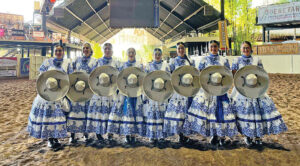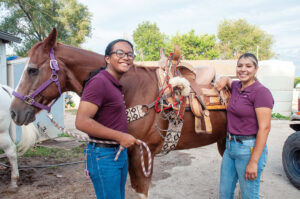Escaramuza Quetzalli
10/5/2022
Members of Escaramuza Quetzalli at the arena at Rancho El Pitayo in Queretaro, Mexico. Photo submitted
You’ve probably heard of horseback riding, but hidden in the heart of Des Moines is an equestrian sport of a different kind. A newly formed drill team called Escaramuza Quetzalli is both breaking barriers and upholding cultural tradition.
Charrería is recognized as the national sport of Mexico, evolving from herding and horsemanship traditions. While charros are a well-established icon of Mexican culture, lesser known is escaramuza charra: the only female event in the charrería. In the event, eight riders perform daring choreographed maneuvers on horseback — sidesaddle. They must be perfectly in sync not just in movement but in appearance.
In Iowa, escaramuza drill teams are few and far between but are gaining traction. Alejandra Piña founded the Quetzalli team in February, bumping up the total of teams in the state to three: all in the Des Moines metro.
“There’s more than you think, but not as many as there should be,” said Anna Garcia, who acts as an informal coach. The team’s official coach lives in California and trains them via FaceTime and the occasional boot camp intensive.
The local escaramuza community is largely centered around Piña’s family, where Mexican rodeo is a deep-rooted tradition. Piña has been riding since age 8. She said she enjoys the sport because her father never limited her with boundaries.
“He took me to roping classes, escaramuza shows, coleaderos, anything with charrería. If I wanted to ride a bull, he would let me,” Piña said. “Basically, the sky was the limit for me.”
Piña’s team practices on a team member’s ranch by the Iowa State Fairgrounds. Her father, Juan, is the only one in the state who sells the extensive gear required in charrería.
“It’s like ballet, with a horse,” he said. “Every movement’s got to be perfect. You have to have perfect timing.”
The perfection is more so required of the women in the sport. It’s evident in the official rule book that outlines the complex scoring system. The men’s rules, Piña said, fill about five pages. The women’s rules? Forty.
The escaramuza routine involves 12 back-to-back exercises. Beforehand, each exercise is drawn out and submitted to the judges, who deduct points based on picture-perfect execution. If a team member falls from a gallop to a trot — minus 10 points. If a formation reveals a gap in space — minus 10 more.
The team can lose points before even stepping into the arena, as their traditional attire and equipment must also uphold to perfect standards. Each piece is handcrafted, created in a dying art only in Mexico. A sombrero costs about $700, saddles another $700, dresses upwards of $500 and custom boots another $100. And don’t forget the jewelry, reins, breast colors, cinches, crinoline and more accessories — all scrutinized by judges in painstaking detail.
“They’re vicious,” Piña said. “They will lift up your skirts and make sure you’re wearing the same bloomers. They check your boots and make sure your spurs are all the same. They make you turn your head to check that your earrings and your bow are all the same.”
Again, the men’s side of charrería is nothing like this.
“It’s just very conservative and machista,” Piña said. “In the United States, it’s not as bad as it is in Mexico. Here, the ladies are more independent. You’ll see them pulling their own trailers; they saddle their horses.”
In Mexico, Piña said escaramuzas received “more of a princess” treatment. Her team got a taste of that last September, when they traveled to Queretaro, Mexico, to compete in the 6º Campeonato Nacional Centenario. The team placed seventh overall.
“It was a surreal adventure that our team got to experience together,” Piña said. “It showed us everything that we are capable of achieving with the right mentality.”
Quetzalli team members range from ages 11 to 27. All are of Mexican heritage except Tyler de Leon. The sole Filipino and male on the team, de Leon said he was drawn by the bravery and community.
“It’s a practice in a culture that’s so well-represented,” he said.
The team’s welcoming culture attracts many out-of-town members who are willing to make the drive for multiple weekly practices. One girl lives in Clarion, an hour and a half away.
“It’s so important that we’re getting our name out there, and what we’re doing and representing,” Garcia said. “There’s tons of little girls or little boys who are looking for that place to belong.”
Escaramuza Quetzalli is open to spectators and new members. They can be found on Facebook or Instagram through @escquetzalli. ♦





















